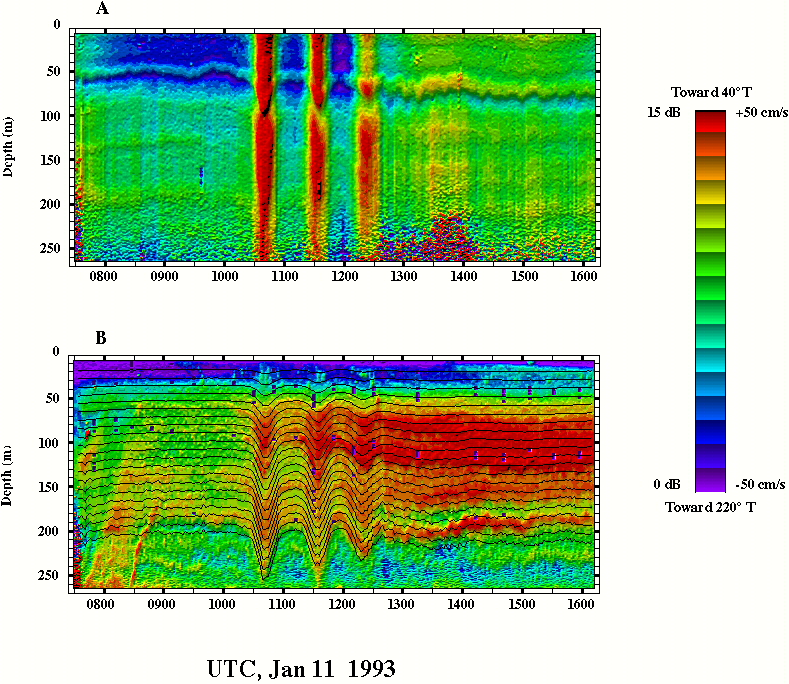
Robert Pinkel
Marine Physical Laboratory
La Jolla, CA 92093-0213
From November 1992 through February 1993 a major air-sea interaction study was conducted in the western tropical pacific. Termed the Intensive Observation Period of the TOGA COARE experiment, the effort involved 15 ships, several aircraft and numerous land stations. The experiment was centered at 2°S, 156°E, in 2 km deep waters above the Ontong-Java Plateau.
During the spring tides of late November, and early January, and early February, groups of internal solitary waves propagated through the COARE domain. They traveled north-eastward at 2.5 ms-1, closely coupled with the semi-diurnal baroclinic tide. Peak amplitudes exceeded 60 m. Velocities in excess of 80 cm s-1 were seen (Figure A).
We report on observations made from the R.V. John Vickers (2°15'S, 156°E) using a vertically profiling coded pulse Doppler Sonar. 8 to 200-300 m, with 2.5 m depth resolution at 2 minute intervals.
The solitons are associated with the 5-7 largest crests of the Spring tides. They do not evolve from the spread of a tidally induced random disturbance, as in Massachusetts Bay (Haury, et al, 1988) or the Sulu Sea (Liu, et al., 1986). Rather, they appear phase-locked to the underlying tide. Aspects of classical solitary wave behavior, soli-bore behavior and parasitic instability are seen in the observations.
A surprising aspect of the observations is that there appears to be a critical threshold for the development of instability. The variation in astronomic forcing between the spring tides associated with soliton formation and those which did not develop solitons is only 10-20% (Feng et al., 1998). It might be that solitary wave behavior often develops but only after the tidal crests pass the COARE site.) In the absence of soliton-like instability, the underlying tide often has a highly skewed waveform. In one instance, a six-hour period cnoidal wave was observed.
The picture one gets of these instabilities is highly dependent on the sensor that is used. Vertical displacement measurements, fixed depth temperature measurements, etc., display the classical soliton signal. Horizontal velocity records, particularly in the mixed layer, emphasize the bore-like nature of the events. While the solitons are clearly mode-one disturbances, propagating at the phase speed of the mode-one tide, it is not clear that the vertical structure of the entire disturbance is well described by a mode-one wave function. Specifically, horizontal currents in the mixed layer seem to be exaggerated relative to deeper observations. This surface enhancement is associated with the bore-like aspect of the events.
The two dimensional nature of motions, when coupled with the ability to measure absolute velocity (GPS), present a unique opportunity. The stream function of the flow can be inferred directly from the observations. Inferred streamlines are given in B. Jitter in the vertical displacement of the deep streamlines results from GPS error. The streamlines are plotted against a background of acoustic scattering intensity which has been corrected for inverse square spreading and attenuation. Observed vertical displacements of scattering layers are in agreement with the calculated streamline. Acoustic scattering strength increases in the core of the first soliton, decreases following its passage, and then increases with the passage of each subsequent crest. Evidence of increased scattering is present in all soliton observations, both day and night. Bragg scattering from micro-scale (.46 cm) fluctuations in the sound speed (salinity) field is responsible for the increase.
The Richardson number perturbation associated with event passage can
be inferred directly from the stream lines. It is, in fact, quite small.
In the absence of pre-existing flows the solitons are capable of inducing
instability in the weakly stratified region of the lower mixed layer, but
not in the thermocline. However, the strong ambient shears associated with
the equatorial current system are always near instability. The solitons
are effective triggers of instability for these marginally critical flows.